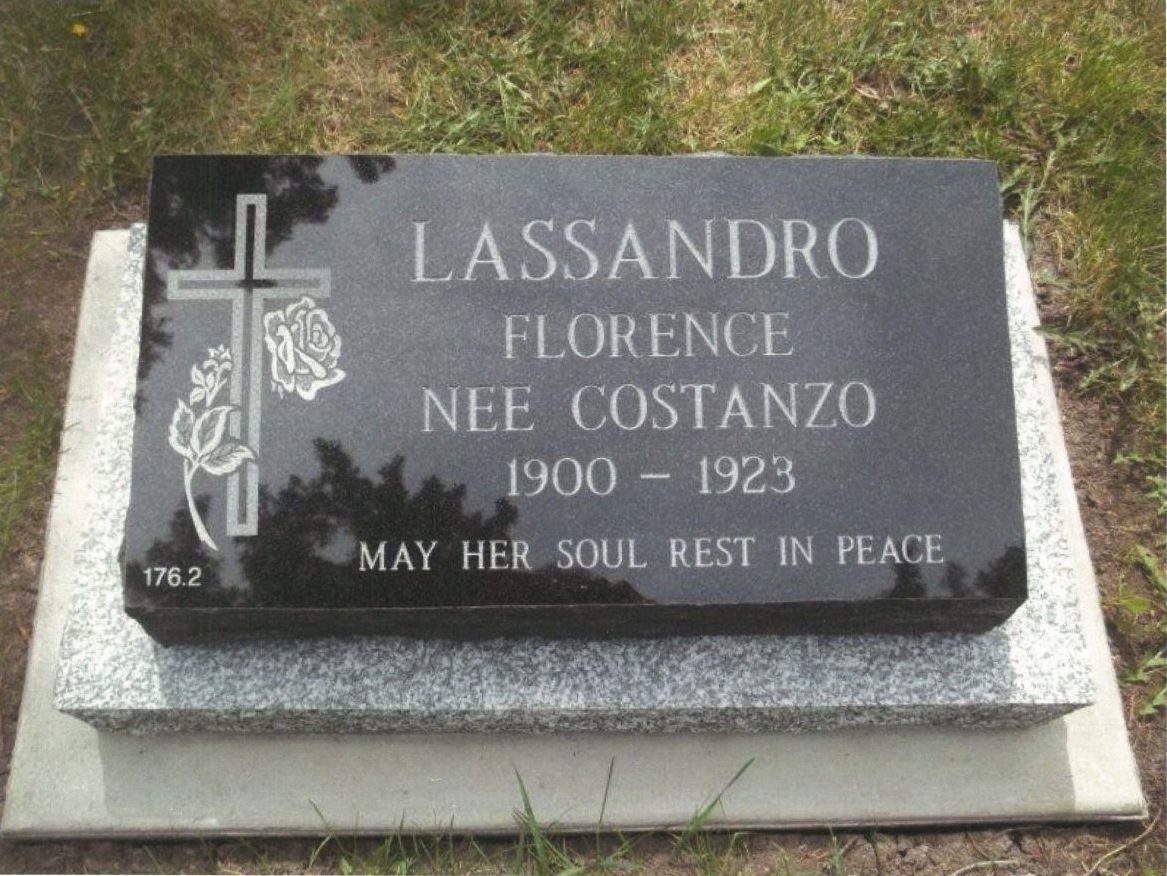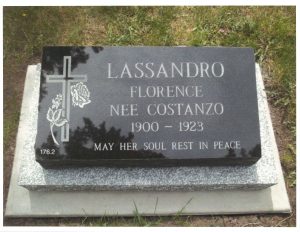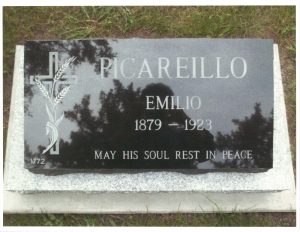On Tuesday, December 19, 2017, I was sitting in Queen’s Bench in Lethbridge, Alberta, and found myself with about two hours, mid-day, between hearings. Mr. Justice Dallas Miller drove me to the renowned Galt Museum to review the travelling exhibition with respect to the lives and deaths of Emilio Picariello and Florence Lassandro. The exhibit was developed by the Fernie Museum and curated by historian Adriana A. Davies, who authored a book titled The Rise and Fall of Emilio Picariello.
Many of you will recall that Emilio Picariello, an Italian immigrant, moved to Fernie, British Columbia with a young family in 1911. He set up numerous successful businesses in the Crowsnest Pass area, including a pasta company, confectionary stores, cigar making business, ice-cream making shop, and bottle collection. However, when prohibition was proclaimed in Alberta in 1916, he became Alberta’s most famous bootlegger. A failed sting operation set up by the Alberta Provincial Police led to the wounding of Picariello’s son, 16-year-old Steve, in Coleman, Alberta on September 21, 1922.
Emilio Picariello, together with Florence Lassandro, a family friend and the wife of his best friend and employee, Charlie Lassandro, confronted APP Constable, Stephen Lawson, on that date and an altercation occurred, during which Constable Lawson admittedly throttled Emilio Picariello, approximately four to six shots were fired by various persons, and one shot struck and killed Constable Lawson.
Emilio Picariello and Florence Lassandro were arrested the next day, September 22, 1922, in Blairmore, Alberta. A preliminary inquiry was held at the Opera House in Coleman on October 2 and 3, 1922, with Magistrate J.W. Gresham presiding, and the pair was tried in the Supreme Court of Alberta at the Calgary Provincial Courthouse from November 27 to December 3, 1922. Attorney General John E. Brownlee personally laid the murder charge and attended every day of the trial. At trial, Mr. Justice W.L. Walsh was the presiding judge. The prosecution team at preliminary inquiry and trial consisted of A.A. McGillivray KC, Sam Helman, and J.W. McDonald KC. At the preliminary inquiry, Charles F. Harris of Lethbridge acted for the accused, and at trial J. McKinley Cameron KC of Calgary, Sherwood Herchmer of Fernie, and D.G. Mackenzie of Blairmore acted for the defence.
On Saturday, December 3, 1922, a jury of six found the defendants “jointly guilty” and Justice Walsh sentenced them to be hanged in the Fort Saskatchewan jail on February 21, 1923.
On appeal to the Appellate Division of the Supreme Court of Alberta, Justices Stuart, Simmons, Beck, Hyndman and Ives rejected 35 points of law raised by defence counsel, but there was one dissenting opinion, that of Justice Beck, which allowed an appeal to the Supreme Court of Canada.
The Supreme Court of Canada, consisting of Justices Idington, Duff, Anglin, Brodeur and Mignault, heard and dismissed the further appeal on April 11, 1923. Numerous pleas for clemency or commutation of sentence were made in Ottawa to the Governor General, Lord Byng, but were unsuccessful.
Emilio Picariello and Florence Lassandro were hanged on May 2, 1923 within the walls of the Fort Saskatchewan Gaol, and Florence Lassandro was the only woman ever hanged in Alberta.
I was fascinated by the story as I walked through the exhibit in the Galt Museum, until I came to the final panel, which read in part:
On May 2, 1923, Picariello and Lassandro went to the gallows at the Fort Saskatchewan Gaol…. They were buried in unmarked graves, next to each other, in an Edmonton cemetery. The families were refused permission for private burials.
The last panel surprised me, because I knew both the location of those graves and the fact that they had now been marked with headstones.
The reason why I was quite sure of both the location of the graves and the fact they were now marked with headstones was because I had acted in a complex matter of a shareholder dispute and estate litigation, which arose after the death of William Connelly, Sr. on March 15, 2007 (Connelly v Connelly-McKinley Limited, 2010 ABQB 515).
Connelly-McKinley Limited, the oldest continually operating funeral home in Edmonton and area, had been founded in 1908 by Joseph William Connelly, and currently has locations in downtown Edmonton, Edmonton South and St. Albert.
In the Connelly-McKinley litigation, I acted for Gerry Connelly and William Connelly, Jr., who sought to have the second last Will of William Connelly, Sr., declared his effective Will, and to have the Connelly-McKinley Funeral Home continue in the family line, to be passed onto a fourth generation, headed by Cameron Connelly. The litigation was successful from the perspective of Gerry and William Connelly, Jr.; they regained control of the funeral home, kept it in the family to be passed down to yet another generation, and were able to probate the second last Will of William Connelly, Sr., which was dated March 20, 2006.
That probated Will, attended as an appendix to this note, set out in paragraph 4(e)(ii) the following specific bequest:
Attachment 1 – Will of William James Connelly
Attachment 2 – Picariello and Lassandro grave locations map
The sum of $2,500.00 to provide a suitable marker for the graves of Emilio Picarrello [sic] and Florence Lesander [sic], who were executed at Fort Saskatchewan, for historical purposes.
Gerry Connelly told me, by way of explanation, that his grandfather, Joseph William Connelly, had been present at the hangings of Emilio Picariello and Florence Lassandro, and had been provided with their bodies for the purpose of interment. His instructions, indeed, were to bury them in unmarked graves, without headstones, and to keep the location of the graves secret. However, William James Connelly became enamoured with the story of Emilio Picariello and Florence Lassandro, and began privately researching their histories, the story of the shooting of Constable Lawson on September 21, 1922, and all of the evidence presented at preliminary inquiry, trial and appeal to both the Supreme Court of Alberta Appellate Division and the Supreme Court of Canada. He became convinced that each of Emilio Picariello and Florence Lassandro had been wrongfully convicted, and that the real shooter was one of the rival bootleggers in the Crowsnest Pass, Jack “Mr. Big” Wilson, of Fernie, British Columbia or Mark “Mr. R.” Rogers of Coaldale, Alberta.
Gerry Connelly advised that he had been left a hand drawn map by his father, who in turn had received it from his grandfather, showing the location of the graves of Emilio Picariello and Florence Lassandro in St. Joachim Cemetery. The cemetery was founded in 1888 on land donated by the Groat family, in Edmonton, initially served the Catholic community in Edmonton, and contains many historic monuments, including the burial crypt of Archbishop Henry Joseph O’Leary, from 1938.
In the fall of 2011, Gerry Connelly, with hand drawn map in hand passed down by Joseph William Connelly to his son and grandson, attended at St. Joachim Cemetery, and located the graves of Emilio Picariello and Florence Lassandro, temporarily marking them for future erection of headstones. Although that original map has now been lost or destroyed, attached is a copy of the St. Joachim Cemetery plot chart now showing the location of the graves.
On December 20, 2011, I corresponded to legal counsel for the estate of William Connelly, Sr., instructing placement of the tombstones. Attached are photographs of the tombstones for Emilio Picariello and Florence Lassandro in these now located graves in St. Joachim Cemetery.
This now completes the final chapter in the fascinating Alberta story of our most famous Prohibition rumrunners. The final panel in the travelling exhibit with respect to these two historical figures can now be amended.





